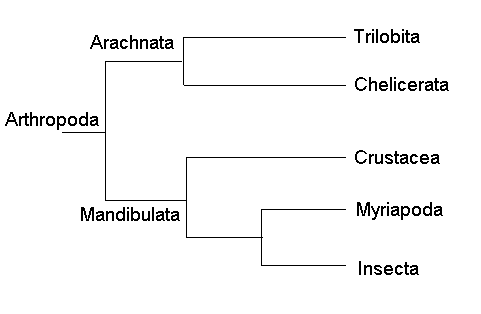Insecta Phylogenetics
Author Mia Yockey
Co-author Kyle Douglass
How we identified the organism:
We originally though that the organism was an arachnid because it looked a lot like a tick. But by observing it a little bit more. We saw it only had six legs and it had two antennae, meaning it was an insect, making it part of the Hexapod Sub phylum. The Scale insect or Cottony Cushion scale insect (Icerya Purchasi) to be exact.

Photo of the unknown organism, the scale bug

https://commons.wikimedia.org/wiki/File:Arthropod_phylogeny.png
Here is an image of the arthropod phylogenetic tree, for better understanding of this topic. So it starts with the phylum Arthropoda then it goes to Arachnata which breaks into Chelicerata ( which contains spiders, scorpions and other arachnids) and Trilobita which is the trilobites and they’ve been extinct.
Arthropod also branches into Mandibulata (Arthropods that contain mandibles, their mouth parts used for biting and cutting) which splits off to Crustacea (which also belongs to the phylum mollusca as stated above). Mandibulata also branches to Myriapoda (centipedes and Millipedes) and Insecta, which is obviously insects and the class that was the focus for the week.
Species name: Scale bug
This organism is known to be a pest, it will burrow into it’s host tree and drain its nutrients for the remainder of its life, or until its host dies. The shell on its back is made up of a waxy cotton
Genus: Icerya
The Genus of the scaled insects. They all the waxy shells and they all live on sap that they consume from their host plant.
Family: Monophlebidae
In this family the organisms have long oval shaped bodies and usually are no bigger then one centimeter long. Most do have a waxy shelling but not all of them do.
Suborder: Sternorrhyncha
This is the suborder that contains aphids, shell insects and whiteflies. Those that are a part of this suborder have a down ward mouth, that is because this suborder contains those who are herbivores and many of them are pests when it comes to crops.
Order: Hemitera (True bugs)
Their mouth is a segmented beak designed for piercing and draining fluids. This order contains insects that feed off of tree sap if their are herbivores, some of them are parasitic, living their whole life off of a host trees or other plants. Some are predatory using their beak like mouth to drain the bodily fluids from its prey. Their name means half of their wings are solid while the other half is soft. The hard part is like shell and the soft part of the wings act as normal wings.
Class: Insecta
This is identified by its segmented body divided into three sections (Head, Thorax and Abdomen), it has three sets of legs and compound eyes. As well as having one pair of antennae. The legs are all on the thorax and no where else on the body.
Order:Coleopotera
This the order of the beetles. Characteristics of the beetles included the tough shell and front wings forming wing case. This is also the biggest order in the phylum, containing around 400,00 species of beetles. The largest family in this order is Curcuiliondea (weevils)
Family: Curculionidae
The family of the weevils, whose distinct trait sis their long snouts that are used to dig into trees to drain their fluids.
sub phylum: Hexapod (Greek for six legs)
The largest group of bugs the phylum. They have all the same traits that an insect has, segmented legs, body divided into three parts, one pair on antennae. What sets Hexapod apart from others of the phylum is the thorax having three segments, a pair of legs of each segment.
Phylum: Arthropod
The most diverse group of invertebrates, which the common trait of a segmented body, an exoskeleton for protection. They have jointed /segmented limbs which they use for movement. Members of this phylum can shed their exoskeleton when they give too big . They have an open circulatory system with a heart and arteries.
Sources:
http://tolweb.org/Hexapoda/2528
https://www.researchgate.net/publication/247491697_The_Tetraconata_concept_Hexapod-crustacean_relationships_and_the_phylogeny_of_Crustacea
http://eol.org/pages/344/overview
http://animaldiversity.org/accounts/Arthropoda/
http://eol.org/pages/344/overview
http://www.nhptv.org/wild/hemiptera.asp
https://www.planetnatural.com/pest-problem-solver/houseplant-pests/scale-control/
https://www.amentsoc.org/insects/fact-files/orders/hemiptera.html
https://en.wikipedia.org/wiki/Icerya
http://tolweb.org/Coleoptera
https://genent.cals.ncsu.edu/insect-identification/order-coleoptera/family-curculionidae/
http://idtools.org/id/scales/factsheet.php?name=6713
https://en.wikipedia.org/wiki/Sternorrhyncha
Posted by
myockey on October 30th, 2017 at 9:48 pm

